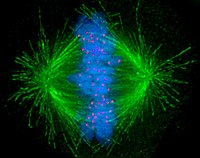
Photo from wikipedia
Mitotic kinetochores assemble via the hierarchical recruitment of numerous cytosolic components to the centromere region of each chromosome. However, how these orderly and localized interactions are achieved without spurious macromolecular… Click to show full abstract
Mitotic kinetochores assemble via the hierarchical recruitment of numerous cytosolic components to the centromere region of each chromosome. However, how these orderly and localized interactions are achieved without spurious macromolecular assemblies forming from soluble kinetochore components in the cell cytosol remains poorly understood. We developed assembly assays to monitor the recruitment of green fluorescent protein–tagged recombinant proteins and native proteins from human cell extracts to inner kinetochore components immobilized on microbeads. In contrast to prior work in yeast and Xenopus egg extracts, we find that human mitotic cell extracts fail to support de novo assembly of microtubule-binding subcomplexes. A subset of interactions, such as those between CENP-A–containing nucleosomes and CENP-C, are permissive under these conditions. However, the subsequent phospho-dependent binding of the Mis12 complex is less efficient, whereas recruitment of the Ndc80 complex is blocked, leading to weak microtubule-binding activity of assembled particles. Using molecular variants of the Ndc80 complex, we show that auto-inhibition of native Ndc80 complex restricts its ability to bind to the CENP-T/W complex, whereas inhibition of the Ndc80 microtubule binding is driven by a different mechanism. Together, our work reveals regulatory mechanisms that guard against the spurious formation of cytosolic microtubule-binding kinetochore particles.
Journal Title: Molecular Biology of the Cell
Year Published: 2021
Link to full text (if available)
Share on Social Media: Sign Up to like & get
recommendations!